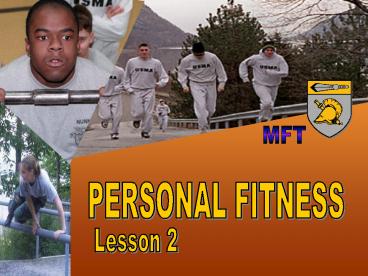Personal Fitness: Lesson 2 - PowerPoint PPT Presentation
Title:
Personal Fitness: Lesson 2
Description:
STEP 1: Analyze the Mission. Mission - become a physically fit leader of ... STEP 2: Develop Fitness Objectives ... STEP 6: Develop 52-Week Training Schedule ... – PowerPoint PPT presentation
Number of Views:122
Avg rating:3.0/5.0
Title: Personal Fitness: Lesson 2
1
(No Transcript)
2
Personal Fitness Lesson 2
- Review Lesson 1
- LO1 7-Step planning process
- LO2 Adherence concepts and strategies
- LO3 Incorporate periodized training
- Review
3
Review
Emotional
Personal Wellness
Intellectual
Spiritual
Social
4
Fitness Optimal Performance
5
SKILL RELATED
HEALTH RELATED
6
LO 1 Personal Fitness Program
Development
7-Step Planning Process
STEP 1 Analyze the Mission STEP 2 Devel
op Fitness Objectives STEP 3 Assess
Your Fitness Level STEP 4 Determ
ine Training Requirements STEP 5
Develop Fitness Tasks (3 detailed weeks)
STEP 6 Develop a 52-week Trai
ning Schedule STEP 7 Con
duct and Evaluate Training
7
STEP 1 Analyze the Mission
Wartime mission Mission essential task list (
METL) Commanders intent ARTEP/ MTP Pract
ical experience (JRTC and NTC)
NCO experience
8
STEP 1 Analyze the Mission
Mission - become a physically fit leader of
character Mission Essential Task List (METL) - t
op 4-5 priorities in AY Commanders intent -
achieve optimal-performance DCFC, IM / Club
MVP, CS All-American Company PT Goals - 80 of
Company earns the APFB - 20 of Company Tab the I
OCT - 20 of Company earns Master of the Sword A
ward (MOS Award) ARTEP/ MTP (DCFC standards) -
PF Text Ch 1
9
STEP 2 Develop Fitness Objectives
Identify specific fitness tasks
Observable, measurable, quantifiable
Realistic and performance oriented
10
STEP 2 Develop Fitness Objectives
1. Earn MOS Award -- score ? 3.67 in Physical
Performance Score PPSY .50(Avg of PF and
LS) .25(Avg 2 APFTs/IOCT) .25(AP)
2. Score 350 on next APFT 86 Push-ups 95
Sit-ups 1130 Two-mile run 3. Score 950/100
on Cow Fitness Challenge Lee Gate Run (1800)
400 Meter Run (64 seconds) Chest Press (2
0 reps at 175 lbs) and Cadence Pull-ups (16
reps) Leg Extension (19 reps at 150 lbs/Leg Curl
(19 reps at 100 lbs and Ankles to the Bar (17 re
ps)
11
STEP 3 Assess the Unit
Utilizing Objectives
1. Identify current fitness level
2. Test standardized performance measures 3.
Identify unit strengths and weaknesses
12
STEP 3 Assess the Unit
Utilizing Objectives
1. Scored a 324 on Fall APFT 72 Push-ups 85 Si
t-ups 1220 Two mile run 2. Strength - abdomina
l strength cardiovascular
endurance 3. Weakness - Upper body strength
13
STEP 4 Determine Training
Requirements
Academic schedule requirements
DCFC events Weaknesses found in assessment
IM, Club or CS practices games
Identify available time for your PF
Areas that have not been assessed
14
STEP 4 Determine Training
Requirements
Earn APFB and MOS Award Run intervals weekly
Work on upper body strength Chest and triceps f
or push-ups and bench press Latisimus Dorsi, tr
iceps, and biceps for chin-ups
Conduct cow fitness challenge to determine
other training requirements Current schedule al
lows for 1hr of physical training per day
15
STEP 5 Determine Fitness Tasks - Planned
Exercises
- 3 Detailed Training Weeks
- Base
- Build
- Peak
- Derived from fitness objectives and training
requirements - Should address all components of fitness
- Should adhere to principle of specificity
16
STEP 5 Determine Fitness Tasks
17
STEP 6 Develop 52-Week Training Schedule
- Review training objectives
- Determine training methods and frequency
- Use FITT Chart
- Build routine into schedule
- Train all 5 components of physical fitness
- Adhere to 7 principles of exercise
- Properly periodized
18
STEP 7 Conduct and Evaluate
Training
- Execute physical training (keep log book)
- Re-evaluate performance at 6 to 10 weeks (using
standardized assessment techniques) - Make appropriate adjustments to physical training
plan - Allow for continuous feedback
19
Lesson Objective 2 Identify strategies for
adherence
20
Form a mental image of the commitment to physical
activity and a healthy lifestyle of this person
- Im lazy and sometimes I dont like to drive.
Ms. Goodfellow, Novi, Michigan explaining why
she likes electronic books. NYT, 28 Aug 2001, p.
C2.
Thought for the Day
21
Stages of Changefor Exercise Adherence
- Stage 1 Precontemplation
- Stage 2 Contemplation
- Stage 3 Preparation
- Stage 4 Action
- Stage 5 Maintenance
22
Strategies for Adherence
- Identify Your Predisposing Factors
- Knowledge, belief that physical activity is
beneficial, confidence in ability,
self-motivation established habits, etc.... - Identify Your Enabling Factors
- Sports skills, availability of equipment,
discretionary time, physical fitness.... - Design Your Reinforcing factors
- rewards for successes, friends/family
affirmation, exercise partner, supportive
employer, logs, etc....
23
Group Discussion
- Excuses for not adhering to exercise plan
- Factors affecting exercise adherence
- Reasons to exercise
- Strategies to begin adherence to exercise plan
- Guidelines to improve exercise adherence
24
Lesson Objective 3 Incorporating Periodization
25
Planning Periodization
- Set goals
- long-term 3-5 years
- medium-term 6 months to 1 year
- short-term
- Schedule key events/competitions (A events) 52
weeks out - Peak for these events
- No more than 2-4 a year
26
Planning Periodization
- Schedule B events that are preparation for A
events - These provide feedback on progress
- Mini-tapers for these events
- Schedule C events that are done for fun or
variety - Train through these events
27
Planning Periodization
- Backwards Plan
- Schedule peaking periods 2-3 weeks before A
events - Schedule build periods 6-8 weeks before peaking
periods - Schedule base periods 8 weeks before build
periods
28
Planning Periodization
- During base and build periods reduce volume every
3-4 weeks by 40 to allow recovery - A Competition periods can last no longer than
2-3 weeks - Repeat the cycle for up to 3 A Competition
periods a year, with abbreviated base periods.































